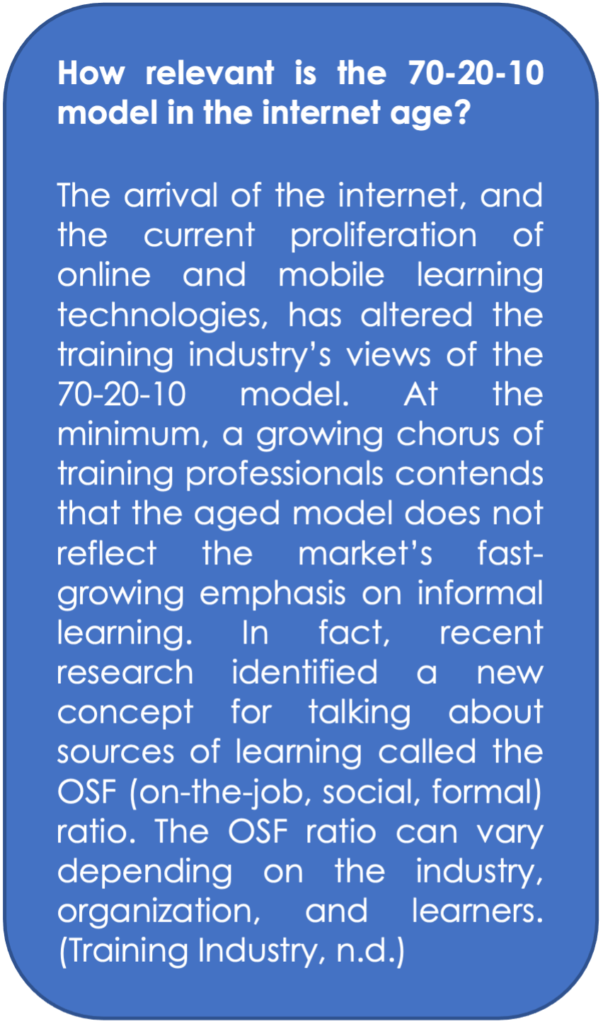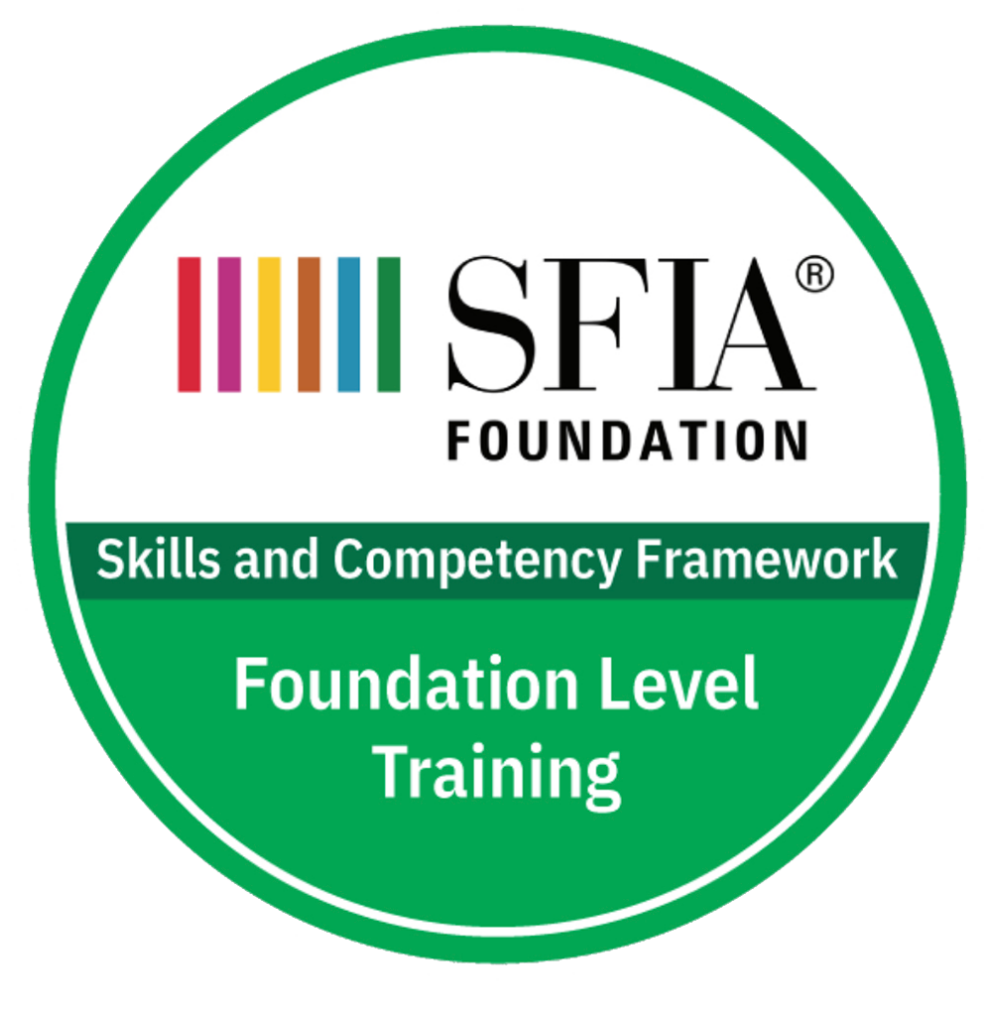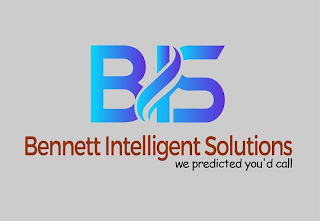Executive Overview
Organizational leaders are faced with the quandary of determining how best to train and develop their workforce remain competitive, retain talent, and attract new and qualified applicants. Industry leaders were led to believe that the 70-20-10 Training Model was the panacea for all things development. Its influence has shaped training and development programs for years. The problem is that the model was never intended for literal implementation and fails to recognize employee needs. Bennett Intelligent Solutions helps leaders identify their training gaps and facilitate a learning map to develop the talent needed to remain competitive, retain talent, and attract new and qualified applicants.

Introduction
The 70-20-10 Learning & Development (L&D) model was developed in the 1980s and subsequently became recognized as the go-to model for L&D programs industry-wide. Essentially, the model posits that 70% of employee training happens through on-the-job experience (OJT), 20% of employee training happens through social learning (near-the-job), and the remaining 10% of employee training happens through structured education (off the job). The premise is that an employee needs to take ownership of their individual training and development to leverage the work experiences to their full potential, while the employee will have access only to purposeful formal programs that complement the work and at a time and with certain qualifications as determined by the employer. The result has been employee dissatisfaction, turnover, and loss of productivity through gaps in qualified and experienced labor. This effect is exacerbated by the post-pandemic work environment and shortage of qualified talent.
- Any Internet search of the 70-20-10 L&D model will provide listings that play up the veracity of the model and its validation as an industry standard. This erroneously suggests a one-size-fits all applicability.
- Employee sentiment dramatically demonstrates a desire for effective and meaningful L&D programs that allow for development and growth. Employees are hungry for learning.
The evidence supports creating and maintain an L&D program that grows talent also helps retain that talent. Employers do not have to provide everything and anything the employee asks, but rather can provide individualized L&D road maps that an employee and manager agree upon and lead to growth and development. Companies such as Bennett Intelligent Solutions (BIS) aid the conduct of organization-specific research and assessment allowing employers to learn their employee’s specific wants and needs, identify the organization’s training gaps, and create L&D programs that provide custom and specific solution beneficial to both employee and employer. In this way, employers avoid the cost burden of one-size-fits all training models, or package deals, and instead invests scant dollars where needed to produce the most return on investment.
How did we get here?
According to Training Industry, considered “the most trusted source of information on the business of learning” (Training Industry, 2022), model developed from research conducted by Morgan McCall, Michael M. Lombardo, and Robert A. Eichinger, authors working with the Center for Creative Leadership, a nonprofit educational institution in Greensboro, NC, to learn the key developmental experiences of successful managers (Training Industry, n.d.). The hypothesis was that learning and development (L&D) best takes place through means other than formal training. While some may still consider it a valuable guide, the model has lost its luster.
What’s the alternative?
We advocate for the On-the-Job, Social, and Formal (OSF) Ratio presented by the Training Industry as a preferred alternative to the traditional 70-20-10 model. We agree that in some instances the 70-20-10 model may be appropriate, but those organizations are not common. Rather, organizations are dynamic, evolving, and need to recognize the unique circumstances determining their L&D platform. In more laborious industry, the ratio might be 90-10, where 90% of learning is OJT and 10% is social learning. In more learned professions, the opposite might be true and higher education may dominate.

Why this is important to you?
Consider these startling statistics concerning the post-pandemic labor environment:
- Among those planning to seek new employment post-pandemic, 80% say they are concerned about their career growth… (T)he majority of this group (72%) are rethinking their skill sets…(Prudential Newsroom, 2021)
- (W)orkers placed… work-life balance (51%) and career advancement opportunities (53%) at the top of their list of priorities… And, more than a third of employees named continuous learning opportunities (36%) as key engagement factors(IBM Institute for Business Value, 2021)
- 65% of workers want the opportunity to participate in an upskilling program(Gallup, n.d.)
- 66% of workers believe they need to train and gain new skills to stay employable in the years ahead, and 71% of workers ranked good learning and development opportunities among the 10 most important factors to work life after the pandemic(The Adecco Group, n.d.)
The War for Talent (Hay, 2002) is a serious one, and you cannot afford to make ill-informed decisions. Couple that with the bullets above and you quickly recognize there is an ever-widening skill gap within organizations and concern that employees do not have the right skills set (Linkedin Learning, n.d.). Employers must take decisive action, while simultaneously acting deliberately to maintain costs.
What’s the answer?
Ask! Khajuria and Khan (2022) noted that better engaged employees better contribute to organizational effectiveness, with the caveat that in addition to engagement, they are provided the skill set and autonomy to work (Khajuria & Khan, 2022, p. 1369). A quick yet effective way to engage employees is through the use of surveys. For a survey to be most effecvtive, it should be timely, targeted, specific, and cost-friendly. BIS can design specific, cost-effective survey instruments specific to your organization.
As noted by the Society for Human Resource Management (SHRM), (o)rganization responsiveness to employee feedback leads to higher retention rates, lower absenteeism, improved productivity, better customer service and higher employee morale. The simple fact that the organization is conducting a survey can send a positive message to employees that their opinions are valued (SHRM, n.d.).
Timely, directed survey instruments – that can range from pulse surveys of a few questions to comprehensive surveys for many questions – provide leaders the employee feedback needed to effectively managing the business, especially concerning L&D. Successful leaders also use the survey approach to monitor success of safety and health programs, employee relations, and employee satisfaction. BIS can design an instrument appropriate for you.

Conclusion
As in the case of the 70-20-10 L&D training model, a one-size fits all approach can be ineffective and costly. That’s why we advocate a more contemporary approach OSF ratio to determine your L&D offerings. The problem for business leaders is determining what the appropriate ratio is for their organization. That’s where Bennett Intelligent Solutions brings the best solution. We offer cost-effective and targeted surveys to derive information with which business leaders can make informed decisions. The result is a more satisfied and more productive workforce with minimal impact to the bottom line.
References
Gallup. (n.d.). The American Upskilling Study: Empowering Workers for the Jobs of Tomorrow. Retrieved from Gallup.com: https://www.gallup.com/analytics/354374/the-american-upskilling-study.aspx
Hay, M. (2002). Strategies for survival in the war of talent. Career Development International, 7(1), 52-55. doi:https://doi.org/10.1108/13620430210414883
IBM Institute for Business Value. (2021, February 24). What Employees Expect in 2021. Retrieved from IBM: https://www.ibm.com/thought-leadership/institute-business-value/report/employee-expectations-2021?mhsrc=ibmsearch_a&mhq=employee%20expectations
Khajuria, G., & Khan, N. (2022). Perceived Organisational Support and Employee Engagement: A. ournal of Positive School Psychology, 6(3), 1366-1384.
Linkedin Learning. (n.d.). The Transformation of L&D. Retrieved from 2022 Workplace Learning Report: https://learning.linkedin.com/content/dam/me/learning/en-us/pdfs/workplace-learning-report/LinkedIn-Learning_Workplace-Learning-Report-2022-EN.pdf
Prudential Newsroom. (2021, April 06). Increasingly, workers expect pandemic workplace adaptations to stick. Retrieved from Prudential.com: https://news.prudential.com/increasingly-workers-expect-pandemic-workplace-adaptations-to-stick.htm
SHRM. (n.d.). Managing Employee Surveys. Retrieved from SHRM.org: https://www.shrm.org/resourcesandtools/tools-and-samples/toolkits/pages/managingemployeesurveys.aspx#:~:text=Organization%20responsiveness%20to%20employee%20feedback,that%20their%20opinions%20are%20valued.
The Adecco Group. (n.d.). Resetting Normal. Retrieved from Adeccogroup.com: https://www.adeccogroup.com/future-of-work/latest-research/resetting-normal-2021/
Training Industry. (n.d.). About. Retrieved from TrainingIndustry.com: https://trainingindustry.com/about/
Training Industry. (n.d.). The 70-20-10 Model for Learning and Development. Retrieved from TrainingIndustry.com: https://trainingindustry.com/wiki/content-development/the-702010-model-for-learning-and-development
Copyright © 2022, Bennett Intelligent Solutions. All rights reserved.
This document is provided for information purposes only and the contents hereof are subject to change without notice. This document is not warranted to be error-free, nor subject to any other warranties or conditions, whether expressed orally or implied in law, including implied warranties and conditions of merchantability or fitness for a particular purpose. We specifically disclaim any liability with respect to this document and no contractual obligations are formed either directly or indirectly by this document. This document may not be reproduced or transmitted in any form or by any means, electronic or mechanical, for any purpose, without our prior written permission
Quick links
Website design by 40 Degrees Media, Ltd.


